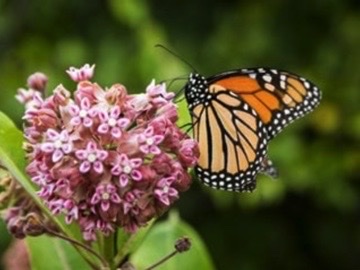Butterfly conservation with milkweed and its medicinal relevance

DEANA TRUONG – The milkweed is a native wildflower that releases a milky sap in response to tissue injury that protects the plant from predators. Some insects, including aphids, milkweed beetles, and monarch caterpillars rely on the milkweed as a protective habitat that also doubles as a food source for these creatures. The monarch butterflies depend upon milkweed as a place of residence to lay its eggs, house the caterpillars that feed on the plant’s foliage, and build its cocoon. Unfortunately, the monarch butterfly population has declined by more than 80% in the past two decades, and an associated decline with the milkweed population has been observed. In response, California allocated $1 million to restore the monarch butterfly population by planting 600 acres of milkweed of various species, including the showy milkweed, narrowleaf milkweed, and desert milkweed within the state.
Foundational research conducted on horses, cattle and sheep have established the effects of ingesting milkweed prove fatal. Milkweed sap is comprised of cardiac glycosides and cardenolides saponins which causes cardiac arrhythmias, hypotension, and bradycardia or tachycardia by affecting the sodium/potassium pumps that allow for action potentials. These deleterious effects are exploited by the insects that feed on the milkweed, which cause no detrimental effects to them, but may affect the predators that prey on them. To protect themselves, the monarch caterpillar simply eats the leaves on the milkweed plant, and to the effect that a predator may eat the caterpillar and ingest the milkweed sap, the predator’s muscles would be rendered weakened or even paralyzed.
With the negative effects that can arise from the milkweed plant, you might wonder why the plant belongs to the genus, Asclepias, named in honor of the ancient Greek god of medicine, healing, and physicians. As it has been told in Greek myths, the skills of Asclepius roused the fear of Zeus, who saw the demigod’s skill as formidable enough to bring the dead back to life, and so the patron god of medicine was struck down by a bolt of lightning. Though because he protested against Zeus’ act, Asclepius’ father Apollo was sentenced to a year of servitude. Asclepius met a tragic end by the hand of his grandfather, though he is remembered to this day as a master of his craft. He is associated with the constellation Ophiuchus, the Serpent Bearer, and in medicine, with the Rod of Asclepius. And it is with these emblems of memorabilia in the stars and in medicine that this patron god of medicine and healing is honored.
As a natural remedy, the milkweed sap can remove warts when topically applied, while the plant’s roots and leaves have been used in alleviating flu-like symptoms, to treat bronchial and pulmonary issues related to various fevers (e.g. typhus and scarlet fever). When boiled, the milkweed’s roots can be eaten to treat bowel or kidney disorders.
You might be familiar with Asclepias sap in its derived form as latex, a rubber-like material found in everyday items. This sap can be collected from the leaves or the stems from the milkweed plant, while the tufts of floss that grow from the milkweed’s seed pod, as part of its fruit, was commonly processed and stuffed on the inside of life-jackets, pillows, and jackets as soft, insulating material. During World War II, a physician named Dr. Boris Berkman advocated for the cultivation of milkweed as an “American crop capable of producing untold benefits” for oil, cellophane, dynamite, surgical dressing, and the insulation in life preservers. After Pearl Harbor, Dr. Berkman acquired federal funding to build his processing facility and under his leadership, the Milkweed Floss Corporation processed milkweed floss in Michigan to fill life preservers for the U.S. military efforts.
Given all that milkweed can allow as a source of seemingly endless possibilities should make conservation efforts in cultivating the plant a priority. Just like a snake’s venom, milkweed can be the cause of cure, a cause of ailment, and a natural source that protects and maintains life other than its own. The milkweed is uncontestedly a versatile plant, and its ease of seed propagation should warrant some extent of funding to increase the plant’s population and the monarch butterfly population with it.
Copy Editor: Aditi Madhusudan
Photography Source: https://www.gardendesign.com/plants/milkweed.html
